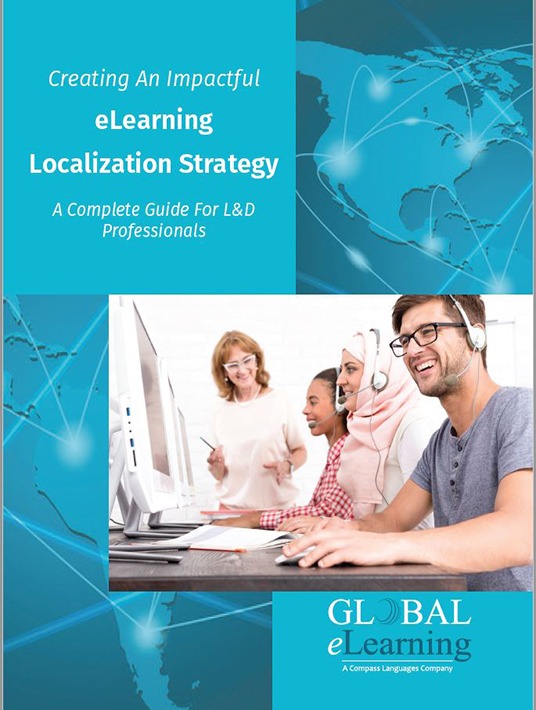Exploring The Challenges Of A Training Content Localization Strategy
Companies often spend in excess of $50,000 to develop sophisticated, interactive eLearning courses. In 2019, the average cost is estimated to be around $22,000 for a 60-minute module. This cost may not even include overhead hours invested by Subject Matter Experts (SMEs) or other top-level managers. There are many challenges that must be overcome when creating a training content localization strategy. In this article, we'll explore the challenges and solutions!

Localization is the process of adapting a product or content to a specific locale or market. Most people think of this process as translation, but Authentic Localization is much more comprehensive and generally includes:
- Adapting graphics to target the audience/culture/market
- Using proper local formats for addresses, zip codes, dates, phone numbers, etc.
- Modifying content for consumption in other regions
- Adapting the design and layout of content
- Converting all references to local requirements (i.e. measurements, currencies, etc)
The process is meant to:
- Capture and transfer knowledge accurately, and
- Ensure that a measure of engagement is achieved so that the target audience can be motivated to learn and comply.
After completing the learning module, some companies will ask their Language Services Company (LSC) to localize this module for global consumption. Perhaps they want to disseminate the information to manufacturing or branch facilities in other parts of the world. They want to ‘translate’ the content into 4-6 six new languages within 3-4 weeks and expect that it will “sizzle” as a learning tool in every language by just simply translating the words and re-recording the script. That's not going to happen without a better strategy.
As discussed in other articles we've published, the ROI of localized eLearning content depends heavily upon the engagement of the end user who happens to live/work in continents that probably are very different than that of the content creators. More than just language, their entire culture is different. It is the mother challenge at the heart of localization effectiveness. Can we connect with an audience that not only speaks differently but also thinks and learns differently?
An authentic localization process must include the assessment of target audience engagement if stakeholders desire to achieve a measurable ROI.
Here are some of the factors involved in challenging, enhancing or disrupting the engagement experience:
1. End User Acceptance Of Source Strategy Or Process
A large eCommerce company approached Global eLearning a couple of years ago with the desire of localizing 40+ Storyline modules into Japanese. In these modules, the company’s most sensitive sales and marketing strategies and processes were being presented. They needed the most secure data management and data transfer methodologies to protect the confidentiality of the information. Global eLearning complied with a strict security protocol all the way through the process of carefully selecting linguists.
After completing the first localized module and requesting feedback from the in-country Japanese reviewer, an issue was unveiled that seemed to have no resolution. And, this criticism occurs more frequently than most companies like to admit. In this case, after establishing that the translation of the original English text was accurate, the reviewer concluded that they simply did not agree with the process/strategy being translated. In her opinion, and the reviewer was a manager in the company’s Japan office, the Japanese office needed to modify the sales strategy itself.
Ultimately, the issue was resolved by getting the Japanese management team to first modify the sales strategies and processes in English that they wanted to implement in Japan. Admirably, U.S. executives allowed these modifications and endorsed them. Only after new English modules were created (for application in Japan), did the localization process get re-started. Then, the project was executed smoothly with this major challenged solved.
2. Knowledge Of The Target Audience
From time to time, we hear our customers request localization support in which they articulate that the language needed is “just” Arabic or French or Chinese. This “just” presumption can be costly and lead to quite a bit of re-work. As an example, to request Chinese must be clarified. If the target audience resides in Mainland China, then we need to translate text into Simplified Chinese and probably use a voice speaking Mandarin. But, there are areas of China that speak Cantonese. If the target audience also lives/works in Hong Kong or Taiwan, then we need to use Traditional Chinese text.
Customers and their localization service partners need to be precise about the target audience. The LSC should be driving out this information as part of its quote preparation or onboarding session.
3. Engagement Inhibitors And Enhancers
It is important for the eLearning content to be free of offensive or unprofessional content or presented in a way that can be misinterpreted, then engagement is lost. Below are some of the finer points of localization that will either connect with them or become an obstacle to learning. For simplicity, we will call these the short list of Do’s and Don’ts that should be considered:
- DON'T: Offensive Or Contradictory Content
It only takes one phrase or one picture in a presentation of dozens or hundreds of slides to turn an audience off, a photo of a bikini-clad woman sun-bathing in an Arabic-speaking country or a policeman brandishing a gun in New Zealand. These pictures, like a certain curse or slang words, will invariably cause many to dismiss the entire presentation. - DON'T: Sloppy Or Unprofessional Presentation
If an eLearning module comes across as sloppy with poor layout design of the new text, orphaned words and/or phrases, or voiceovers that are not in synch with screen effects or lip movements, then the audience will believe that it does not deserve the company’s best effort. Presentations need to flow, just like the source does, and be as flawless. - DO: Localize All Important Details Of The Information
The date of September 11 is very important in American culture as of 2001. It is widely expressed as “9/11” in context references. Yet, for most of the world that date must be written as 11/9/2001 for them to read it correctly as “September 11, 2001”. Otherwise, it is read as “November 9”. Localization means to put data in a form that is conventional for the target audience so that it is comprehended without error. Not just dates and times, but correctly identifying the local holidays, displaying contact information in the right order, and addressing local business customs make the presentation relevant. - DO: Use Appropriate Voices And Correct Tone
Voiceovers in eLearning modules or in training videos are super effective in enhancing the messaging of the new language presentations. Subtitles have a purpose, but it interrupts the flow of learning. In selecting voice talent(s) be sure to grasp the gender preference of the target audience in a professional learning environment. In addition, adjust the tone of the voice, the pace of script reading, and any displays of vocal emotional around the expectations of the target audience. - DO: Earn Attention Through Appropriate Cultural References
In American culture, we like to encourage others by using the phrase, “knock it out of the park!”. In presentations, we may use a picture of Hank Aaron or Babe Ruth swinging a baseball bat and connecting for a home run. That baseball-reference will be understood by maybe 8-10 cultures in the world but its message to only one or two. Be appropriate in using visual references that are clear to the target audience. Soccer is a global sport and the exclamation of a “Goooaaalll!” is universally understood. In China, references to the Christmas holiday has little emotional appeal, but the Chinese New Year celebration, a week-long celebration, is observed by all Chinese.
The Learning & Development professional is facing a growing demand for global adaptations of corporate training content. Download our eBook Creating An Impactful eLearning Localization Strategy: A Complete Guide For L&D Professionals to discover how a great eLearning localization strategy can help you turn your employees into rising stars and unlock their true potential. It also features tips to go global by launching an engaging program for your multicultural workforce.

